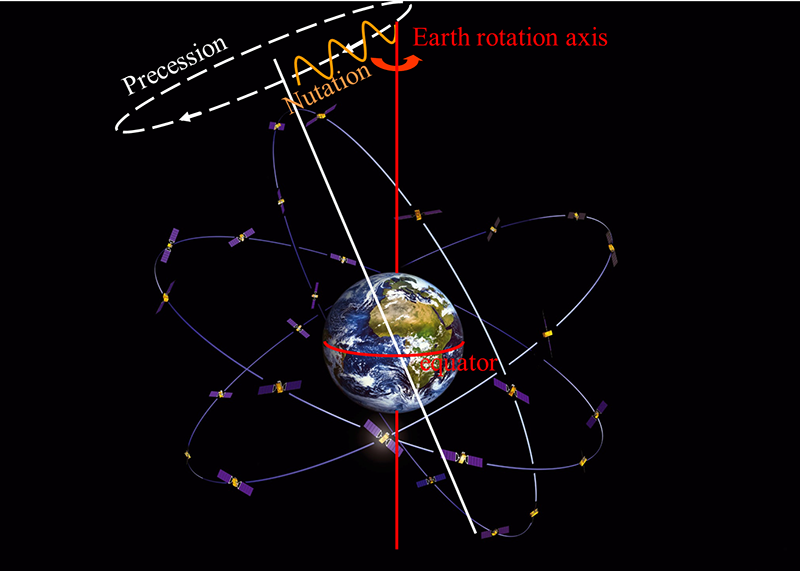The gravitational pull of the Sun and Moon on the Earth, as well as many other smaller geophysical effects (including motions of Earth’s fluid core), cause Earth to wobble. Earth is not a perfect sphere but an ellipsoid flattened at its poles, so the forces acting upon Earth alter both its speed of rotation and the orientation of the axis on which it spins. The term “precession” describes the long-term trend of this latter motion, which is roughly circular and analogous to the motion of a spinning top. “Nutation” is the name given to shorter-term periodic variations: wobbles along this circular track.
Present observations allow variations in Earth’s rotation to be measured at the centimeter level.
Last September, scientists gathered for a workshop in Brussels, Belgium, to discuss the role of Earth’s core in its nutation and to gain further insight into Earth’s interior processes. This was the first such workshop to be held within the framework of the newly established RotaNut project in the frame of an ERC (European Research Council) Advanced Grant.
Precession causes the rotation axis of Earth to move in space at about 1.5 kilometers each year. Nutation introduces periodic variations on the order of 600 meters back and forth around the precession circle (from a vantage point looking down on the planet’s pole). Present observations allow these motions to be measured at the centimeter level. Speakers noted how such observations show that there are significant differences on the order of a few centimeters (1 milliarc second, or about 3 centimeters) between observations and the standard theoretical model of precession and nutation. The theoretical model was adopted by the International Astronomical Union in 2000 and by the International Union of Geodesy and Geophysics in 2003.

The theoretical model is based on the idea that Earth reacts as a deformable object with a deformable inner core, a fluid outer core, a deformable mantle that is both viscous and elastic (it can flow and stretch), an atmosphere, and oceans. But the theoretical model is not perfect, attendees discussed. In particular, scientists still don’t understand the interactions between the inner core, fluid outer core, and mantle well enough to properly model them.
Because Earth’s core transfers angular momentum to the mantle, interactions between the two regions play an important role in nutation modeling.
Because the core transfers angular momentum to the mantle, interactions between the two regions play an important role in nutation modeling, meeting participants agreed. The current nutation model incorporates the effect of the flattening of the core due to Earth’s rotation and the fluid pressure and gravitational effects on that flattened boundary, as well as the effects of a simple uniform, dipolar magnetic field.
Today, we understand that there are important contributions from other components of the magnetic field and possibly other effects, like the viscosity of the inner core, the viscosity of the outer core, and core stratification. In addition, the core-mantle boundary is not smooth, and pressure forces acting on these topographical features could also play an important role.
The workshop shed light on all of the mechanisms that might be influencing Earth’s nutation, including the possible interaction between rotational modes and inertial modes inside the liquid core. Future meetings will highlight outcomes and new insights that emerge from the discussions held during this meeting.
The work of Veronique Dehant was performed at the Royal Observatory of Belgium under funding from the European Research Council under the European Union’s Horizon 2020 research and innovation program (advanced grant agreement 670874). The work of Richard Gross was performed at the Jet Propulsion Laboratory, California Institute of Technology, under contract with NASA.
—Veronique Dehant, Royal Observatory of Belgium, Brussels; and Richard Gross (email: [email protected]), Jet Propulsion Laboratory, California Institute of Technology, Pasadena
Citation:
Dehant, V, R. Gross (2017), Earth’s wobbly path gives clues to its core, Eos, 98, https://doi.org/10.1029/2017EO070783. Published on 11 April 2017.
Text © 2017. The authors. CC BY-NC-ND 3.0
Except where otherwise noted, images are subject to copyright. Any reuse without express permission from the copyright owner is prohibited.

